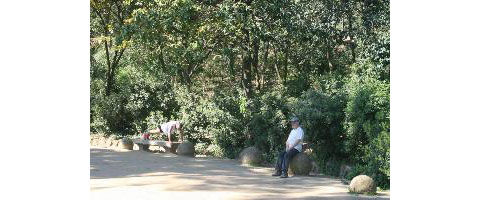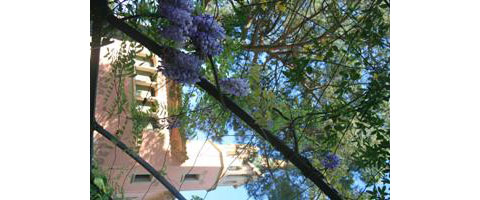Courtesy of My Generation.
Barcelona’s Guell Park was originally planted out to reflect the mosaics of Antoni Gaudi. As ROBYN YOUSEF discovered, that vision is continued there vigorously today.
The man beside me was applying his make-up, readying a great rubber meat joint and adjusting a faux leopard skin tunic for his regular ‘Cave Man’ appearance, while others were sorting their trinkets to sell and tourists were either hanging out of the windows or fervently studying their Gaudi leaflets. On this beautiful April day, even the city bus had a fiesta-like atmosphere for the 25-minute climb from Barcelona Centre up to the 14-hectares heritage site, Guell Park.
And while tourists were plentiful, as a passionately nationalistic Catalonian, Gaudi, would have liked the fact that so many locals were enjoying his park that day. The great architect, who lived from 1852 until 1926, designed nearly all of his buildings for Barcelona and you need only a short walk through the city to view most of his significant works.

Guell Park was originally designed as a stylish “suburb” of gardens for local aristocracy and commissioned by Gaudi’s patron, Eusebi Guell. But, only two properties instead of the 60 envisaged were actually built on the hill property northwest of Barcelona. Gaudi lived in one of the two houses which now is a museum.
The Barcelona City Council bought the Muntanya Pelada property in 1922 and in the following year converted it to a municipal park. In 1984 UNESCO placed the park under an international preservation order.
The lowest point of the park is the entrance, from which a dramatic double staircase leads to the hypostyle chamber, the ceiling of which serves as the floor of the huge public square. Gaudi apparently planned this terrace as a place for people to gather and to stage festivals and stage productions.
His vision for this sort of “marketplace” has been well and truly achieved. It’s a vibrant space backed by the snake bench wall covered in a huge variety of mosaics and on both occasions I’ve visited has been packed with visitors, performers and sellers of trinkets. Every so often a call of “ la policia, la policia” (”police, police”) goes up and the colourful salespeople scramble to conceal their equally colourful trinkets – ranging from Spanish fans made in China through to castanets, scarves and hats.
The park has a network of twisting roads following the natural contour of the land as Gaudi avoided levelling the site. The planting, which has a totally natural theme, is dominated by Pine trees – Aleppo and Stone Pines, as well as Olives,
Canary Island Palms and the Mediterranean shrub, Carob. Spring was showing off her flashy colours that April day with great bunches of lilac-coloured Wisteria, mingled with the hot shades of Bougainvillea, Irises in a variety of colours and those Mediterranean standards, Plumbago and Geraniums.
There are panoramic views of Barcelona from all over the park and every so often a gentle Gaudi reminder that you’re not in just any city park. Suddenly you realize that tree you thought was a palm is actually a ceramic column topped by a flower planter. When you visit the cavern-like toilets, you appreciate the facilities are concealed by walls not just smothered by Wisteria and Bougainvillea, but also providing homes for dozens of pairs of nesting pigeons. From all over the park there are also many views of the delicately designed turrets with their gleaming ceramics and many creative viaducts and colonnades.

That winding perimeter wall is not just an enormous piece of ceramic art as Gaudi built it with practical purposes in mind. The ceramic skin of the mosaics makes the wall waterproof, and as the smooth covering makes it difficult to climb, it also works as protection from intruders. Another interesting fact about this wall (where you could spend a whole day just enjoying the variety of mosaic patterns) is that Gaudi went to great lengths when designing it to ensure that the seating and back of the bench were physiologically correct for the human body. The architect is said to have sat a naked man on pliable plaster and then reproduced the imprint to make for comfortable seating!
The park was almost totally built of material found on the site. With the streets designed in the form of viaducts and passages, Gaudi used the stone and rubble excavated to construct the buildings. For the glistening ceramic coverings, he used a collage method with waste pieces he got from leading ceramic workshops.
His pride in Catalonia has been displayed in this park, along with the significance of symbolism and sense of practicality. A snake’s head near the central sector of the park serves as a symbol of the Catalonian coat-of-arms, while that huge, multi-coloured dragon which represents the guardian to the park also symbolizes Python (the guardian of the subterranean waters) and has a concealed cistern which holds 2,600 gallons of rainwater.
The maintenance of the park today is the responsibility of the Department of Environment at the Barcelona City Council. I spoke to Anna Bernal, the curator of the park, who has worked there for the last three years.
“There is a brigade of 10 people at Park Güell, organised in daily cleaning squads for the gardens. There is also a maintenance group for the buildings and heritage site, which varies according to the jobs needed, and there are staff who enter the park according to specific tasks like specialized pruning, maintenance, infrastructure, personnel information, security, water, etc. We also employ additional security personnel,” Bernal explains.
She says the style of the gardens in the “common areas” of the park remain as it was when originally designed and planned.
“The park was conceived at the beginning as a 'city garden', following the British model of that time, when everyone would have their own garden, but most of these plots didn’t get built, and were colonized by native plants such as pines and oaks. However, the common gardening areas fit with the original project.”
She says the park includes vast plant diversity. “We have the Vallcarca forest, just behind the monumental zone with Aleppo Pine, Stone Pine, Olive and Carob Trees mainly with Mediterranean scrub plants. In the monumental area, we have Wisteria or Bougainvillea on some bridges. Landscape trees are mainly Carob, Olive, Phoenix or Canary Island Palm, Judas Tree, Privet Tree, Silver Wattle and Sweet Cherry.”
Other plants used throughout the park include Plumbago, Agaves, Mastic, Clivia along with some Roses, Irises and others perennials as well as many aromatic plants. “The Garden of Austria has a variety of perennials used in the early twentieth century.
“Many of the trees (and some other plants) date back to the days the park was started. These include Cedars, Phoenix Palms, Bougainvillea, Wisteria, Olives and Oaks. But, especially noteworthy are the Carob plants under the bridges, which was not planted at the time of their construction, but architecture adapted to nature.
“Today this Carob Tree has grown seeking sunlight, and this is one of the most valuable elements of the park. The example is clear; that respect for nature has valuable rewards, and summarizes the respect and value that Gaudi had for nature as God's work,” Bernal says.
She explains that all current work at the park is designed to restore the original look of the park, and adapt it to current needs such as the provision of protection railings, street lamps and the recovery of original plants.
“One of the tasks that we are finishing now is the park's water system. This will solve many problems of up keeping for the plants and allows us landscape areas we had not been able to do. The mountainous terrain conditions the vegetation but is also compatible with our work. The biggest problem is the misuse of a garden and this can be a very tricky issue due to the large influx of visitors.”
The garden is open from sunrise to sunset every day of the year. Recent improvements include a remote controlled irrigation system and the gardening team is also working on a special project to recover the style of planting and the species used at the beginning of the century. “We are trying to plant species with flowers across all seasons. The truth is that regarding this aspect it has been very easy to work along these lines, because the colours of the small ceramics used to decorate were inspired in nature, which is what we are trying to recover.”
Bernal says the number of visitors to the park is increasing a lot. She highlights just how important the work is to their Catalan culture and the significance of Gaudi’s heritage. And what she requests from visitors to Guell Park is simple.
“What we ask for is respect and to be aware that we are in a monumental space, which explains a delicate moment in the history of our city.”
Robyn Yousef travelled to Barcelona with the assistance of Singapore Airlines and the Barcelona Tourism Office.









Join the Discussion
Type out your comment here:
You must be logged in to post a comment.